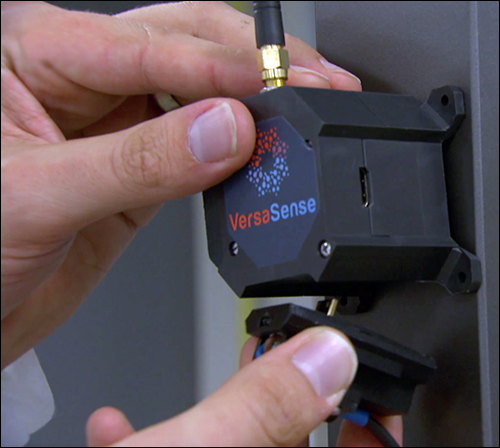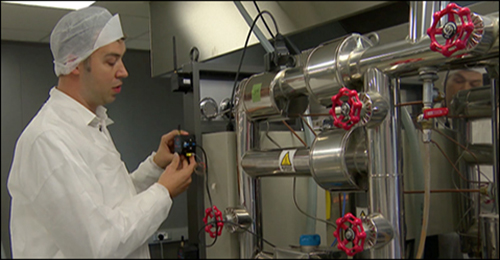Internet of Things (IoT) company VersaSense has released a low-cost wireless network-based solution for capturing data from sensors, which can be easily deployed in high volume, the company reports. The solution, known as IoT Fabric, consists of a sensor hub that can be linked to most sensors, along with cloud-based software to manage the collected sensor data. Several utility companies and large manufacturers are currently tracking the conditions at their facilities via smart meters, valve-position monitors, leak detectors and other sensors.
The system employs Narrowband IoT (NB-IoT), a low-power wide-area network (LPWAN) within the cellular standard, and operates with such standard IoT networks as 3G, Wi-Fi and LoRa. The solution’s software can be hosted on a cloud-based server or on a user’s own database, and can be connected to IoT platforms such as Microsoft Azure, Siemen’s Mindsphere or IBM Watson.
VersaSense, based in Flanders, Belgium, is a spinoff company of the imec-DistriNet research group at the University of Leuven (KU Leuven). The researchers were seeking an alternative to existing IoT solutions that would be easy to use and low in cost, says Danny Hughes, the firm’s CTO and co-founder, who formed the company in 2016 with partners Nelson Matthys (VersaSense’s CEO) and Christopher Huygens (the company’s COO).
One challenge that large industrial companies face when it comes to implementing IoT solutions, the group found, is that every deployment needs to be customized for a specific user. “What we saw was that everyone was going back to square one for every new system [they developed],” Hughes says. That makes solutions costly and time-consuming to deploy, he adds. Instead, VersaSense aimed to create a single solution that could be easily adapted to any end user and application. Its technology is now being employed by companies that utilize tens or hundreds of wireless sensor hubs with many hundreds of sensors, often in harsh industrial environments.
“Our clients are experts in their domain,” Hughes states. “They know the data they need and they can work with the data, but are missing the way to acquire it.” For instance, he explains, some may need to have better preventative maintenance information, using vibration analysis simply to predict when a particular piece of equipment, such as a pump, is likely to fail.
VersaSense spent several years developing the solution. “We were trying to take our IoT knowledge and put that into a generic product,” Hughes recalls. The team wanted to offer a system that could be installed by those with little technical background, and with no programming required. At the center of the system is the wireless device (or hub), manufactured by the Belgian company. It has a battery life of ten years; includes NB-IoT, LoRa and SmartMesh IP radios; and can be connected to up to three out of 40 sensors provided by VersaSense, as well as to thousands of third-party sensors that customers may already be using. Sensors can be plugged directly into the device, or attached via a cabled connection.
A company first places an IoT order with VersaSense, and it comes without any preformatting requirements. Instead, the wireless hub configures itself based on which sensors are connected. It then automatically forwards data to the server, using NB-IoT on the company’s existing cellular network, or LoRa or SmartMesh IP.
Upon receiving the hub, a user can simply attach the sensors. The hub awakens when a sensor is plugged into it, at which point it immediately begins trying to pair with the back-end software. At that point, Hughes says, the hub appears on the software and sensor-based data begins to flow. All subsequent control is carried out via a Web-based interface.
“We can do very large site installations in a single day,” Hughes states. “When we say ‘plug-and-play,’ we mean zero-configuration, zero-skill installation. You just attach it, and the data is online.” For the company, he adds, it’s critical that the technology be something that those who maintain the machines can easily install and manage.
Although the firm makes some sensors, it considers itself primarily a software provider. “We only build sensors when we need to,” Hughes says. The catalog not only offers about 30 sensors from VersaSense, but also sells approximately 15 different interface pods for other sensors. In addition to NB-IoT, it offers LoRa and SmartMesh IP IEEE 802.15.4e standard physical layers.
VersaSense sells its solution directly to clients and is increasingly working with partners as well. “Our sales are increasing through partnerships,” Hughes reports. Its customers, in addition to utility companies, include fast-moving consumer goods, automotive and food-processing firms. Several businesses have expressed an interest in collecting data that includes tracking conveyor belt performance based on rotation measurements, or temperatures that are rising higher or lower than what is designated as acceptable. The IoT company has approximately 100 installations in place throughout 30 countries worldwide.
VersaSense offers the solution as a platform-as-a-service model, while partners are building their own cloud-based solution using the technology. The company also builds full solutions for customers that request it. While 75 percent of its customers are now in Europe, Hughes says, the technology is being used by several Fortune 500 companies in the United States as well.
Images courtesy of Kanaal Z.



